
List of national historic sites of Canada
Encyclopedia
National Historic Sites of Canada are places that have been designated by the Minister of the Environment
of Canada
, on the advice of the Historic Sites and Monuments Board of Canada (HSMB), as being of national historic significance. Parks Canada
, a federal
agency, manages the National Historic Sites program. As of August 2010, there are 956 National Historic Sites of Canada, of which 167 are administered by Parks Canada; the remainder are administered and/or owned by other levels of government or private entities. The sites are located across all ten provinces and three territories
, with two sites located in France
(the Beaumont-Hamel Newfoundland Memorial
and Canadian National Vimy Memorial
).
Canada has related programs for the designation of Persons of National Historic Significance
and Events of National Historic Significance
.
in the late 19th century and early 20th century led to an increased interest in preserving Canada's historic sites. The 1908 tricentennial of the founding of Quebec City
, and the establishment that same year of the National Battlefields Commission to preserve the Plains of Abraham
, acted as a catalyst for federal
efforts to designate and preserve historic sites across Canada. At the same time, the federal government was looking for ways to extend the National Parks system into Eastern Canada
. The more populated east did not have the same large expanses of undeveloped federal Crown land
that had become parks in the west
, so the Dominion Parks Branch (the predecessor to Parks Canada) looked to historic features to act as focal points for new national parks. In 1914, the Parks Branch undertook a survey of historic sites in Canada, although the objective of the exercise was on creating new recreational areas rather than preserving historic places. Fort Howe
in Saint John, New Brunswick
was designated a National Historic Park in 1914. Fort Howe was not a site of significant national historic importance, but its designation provided a rationale for the acquisition of land for a park. Fort Anne
in Annapolis Royal, Nova Scotia
was similarly designated in 1917.
In 1919, William James Roche
, the Minister of the Interior, was concerned over the fate of old fur trade
posts in Western Canada, and he was also being lobbied by historical associations across Canada for federal funds to assist with the preservation and commemoration of local landmarks. At the same time, the Department of Militia and Defence was anxious to transfer old forts, and the associated expenses, to the Parks Branch. Roche asked James B. Harkin
, the first Commissioner
of Dominion Parks, to develop a departmental heritage policy. Harkin believed that the Parks Branch did not have the necessary expertise to manage historic resources; he was troubled by the relatively weak historic value of Fort Howe, the country's first historic park, and feared that the Branch's park improvements were incompatible with the heritage attributes of Fort Anne, the second historic park.
, a noted authority on the War of 1812
and the history of Ontario
, was chosen as the Board's first chairman, a post he held for twenty years. The first place designated and plaqued under the new program was the "Cliff Site" in Port Dover, Ontario
, where two priests claimed sovereignty over the Lake Erie
region for Louis XIV of France
in 1670.
Due to a lack of resources, the HSMBC limited itself to recommending sites for designation, and the focus of the program was on commemoration rather than on preservation. Benjamin Sulte
, a member of the HSMBC, wrote to Harkin in 1919 about the significant ruins at the Forges du Saint-Maurice
, demonstrating his preference for the installation of a plaque over restoration: "All that can be done in our days is to clear away the heap of stones, in order to reach the foundation walls and plant a sign in the centre of the square thus uncovered."
In the early years of the program, National Historic Sites were chosen to commemorate battles, important men, the fur trade and political events; the focus was on the "great men and events" credited with establishing the nation. Of the 285 National Historic Sites designated by 1943, 105 represented military history
, 52 represented the fur trade and exploration, and 43 represented famous individuals (almost entirely men). There was also a strong bias in favour of commemorating sites in Ontario over other parts of the country (with some members of the HSMBC even concluding at one time that there were no sites at all in Prince Edward Island
worthy of designation). The then prominence of sites in Ontario related to the War of 1812
and the United Empire Loyalists has been attributed to the influence of Cruikshank, resulting in a "veritable palisade of historical markers along the St. Lawrence
" commemorating the resistance to Americanism. Proposals to designate sites related to the immigration of Jews, Blacks and Ukrainians
to Canada were rejected.
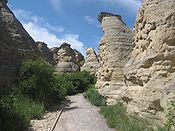 As time passed and the system grew, the scope of the program and the nature of the designations evolved. By the 1930s, the focus of the heritage movement in Canada had shifted from commemoration to preservation and development. The change was most marked in Ontario, where the Niagara Parks Commission
As time passed and the system grew, the scope of the program and the nature of the designations evolved. By the 1930s, the focus of the heritage movement in Canada had shifted from commemoration to preservation and development. The change was most marked in Ontario, where the Niagara Parks Commission
was restoring Fort George
and the Department of Highways was restoring Fort Henry
. It took the Great Depression
to create opportunities for significant heritage preservation projects at the federal level. Although the HSMBC took little interest in these efforts, limiting itself to a commemorative role, the Parks Branch made wide use of government relief funds to hire workers to assist with the restoration of old forts.
In 1943, the interim chairman of the HSMBC, Frederic William Howay, urged his fellow Board members to consider a broader range of designations. In 1951, the Royal Commission on National Development in the Arts, Letters and Sciences
highlighted the imbalances of the National Historic Sites program, urging a more ambitious program with more attention paid to architectural preservation. In 1955, the Historic Sites and Monuments Act was amended to allow the designation of buildings due to their age or design, resulting in a new focus on the designation of Canada's built heritage. The 1950s also marked the beginning of the "big project" era, which reached its apogee in the 1960s, in which the federal government invested significant funds in the restoration and reconstruction of high-profile National Historic Sites such as the Halifax Citadel, the Fortress of Louisbourg
, the fortifications of Quebec City
and the historic core of Dawson City.
By the 1990s, three groups were identified as being underrepresented among National Historic Sites (namely, Aboriginal peoples
, women and ethnic groups other than the French
and the English), and efforts were subsequently made to further diversify the designations. It was at this time that the use of the term "National Historic Park", then still used for the class of larger National Historic Sites deemed to be of "extraordinary value to Canadian history", was phased out.
Designation as a National Historic Site provides no legal protection for the historic elements of a site. However, historic sites may be designated at more than one level (national, provincial and municipal), and designations at other levels may carry with them some legal protections.
Most National Historic Sites are marked by a federal plaque bearing Canada's Coat of Arms. In earlier years, these plaques were erected on purpose-built cairn
s, and in later years have been attached to buildings or free-standing posts. These maroon and gold markers are typically in English and French, though some are trilingual where another language is relevant to the subject being commemorated.
Minister of the Environment (Canada)
The Minister of the Environment is the Minister of the Crown in the Canadian Cabinet who is responsible for overseeing the federal government's environment department, Environment Canada...
of Canada
Canada
Canada is a North American country consisting of ten provinces and three territories. Located in the northern part of the continent, it extends from the Atlantic Ocean in the east to the Pacific Ocean in the west, and northward into the Arctic Ocean...
, on the advice of the Historic Sites and Monuments Board of Canada (HSMB), as being of national historic significance. Parks Canada
Parks Canada
Parks Canada , also known as the Parks Canada Agency , is an agency of the Government of Canada mandated to protect and present nationally significant natural and cultural heritage, and foster public understanding, appreciation, and enjoyment in ways that ensure their ecological and commemorative...
, a federal
Government of Canada
The Government of Canada, formally Her Majesty's Government, is the system whereby the federation of Canada is administered by a common authority; in Canadian English, the term can mean either the collective set of institutions or specifically the Queen-in-Council...
agency, manages the National Historic Sites program. As of August 2010, there are 956 National Historic Sites of Canada, of which 167 are administered by Parks Canada; the remainder are administered and/or owned by other levels of government or private entities. The sites are located across all ten provinces and three territories
Provinces and territories of Canada
The provinces and territories of Canada combine to make up the world's second-largest country by area. There are ten provinces and three territories...
, with two sites located in France
France
The French Republic , The French Republic , The French Republic , (commonly known as France , is a unitary semi-presidential republic in Western Europe with several overseas territories and islands located on other continents and in the Indian, Pacific, and Atlantic oceans. Metropolitan France...
(the Beaumont-Hamel Newfoundland Memorial
Beaumont-Hamel Newfoundland Memorial
The Beaumont-Hamel Newfoundland Memorial is a memorial site in France dedicated to the commemoration of Dominion of Newfoundland forces members who were killed during World War I. The preserved battlefield park encompasses the grounds over which the Newfoundland Regiment made their unsuccessful...
and Canadian National Vimy Memorial
Canadian National Vimy Memorial
The Canadian National Vimy Memorial is a memorial site in France dedicated to the memory of Canadian Expeditionary Force members killed during the First World War. It also serves as the place of commemoration for First World War Canadian soldiers killed or presumed dead in France who have no known...
).
Canada has related programs for the designation of Persons of National Historic Significance
Persons of National Historic Significance (Canada)
Persons of National Historic Significance, , are people designated by the Canadian government as being nationally significant in the history of the country. Designations are made by the Minister of the Environment on the recommendation of the Historic Sites and Monuments Board of Canada....
and Events of National Historic Significance
Events of National Historic Significance (Canada)
Events of National Historic Significance are events that have been designated by Canada's Minister of the Environment, on the advice of the Historic Sites and Monuments Board of Canada, as being defining actions, episodes, movements or experiences in Canadian history...
.
Early developments
Emerging Canadian nationalist sentimentCanadian nationalism
Canadian nationalism is a term which has been applied to ideologies of several different types which highlight and promote specifically Canadian interests over those of other countries, notably the United States...
in the late 19th century and early 20th century led to an increased interest in preserving Canada's historic sites. The 1908 tricentennial of the founding of Quebec City
Quebec City
Quebec , also Québec, Quebec City or Québec City is the capital of the Canadian province of Quebec and is located within the Capitale-Nationale region. It is the second most populous city in Quebec after Montreal, which is about to the southwest...
, and the establishment that same year of the National Battlefields Commission to preserve the Plains of Abraham
Plains of Abraham
The Plains of Abraham is a historic area within The Battlefields Park in Quebec City, Quebec, that was originally grazing land, but became famous as the site of the Battle of the Plains of Abraham, which took place on 13 September 1759. Though written into the history books, housing and minor...
, acted as a catalyst for federal
Government of Canada
The Government of Canada, formally Her Majesty's Government, is the system whereby the federation of Canada is administered by a common authority; in Canadian English, the term can mean either the collective set of institutions or specifically the Queen-in-Council...
efforts to designate and preserve historic sites across Canada. At the same time, the federal government was looking for ways to extend the National Parks system into Eastern Canada
Eastern Canada
Eastern Canada is generally considered to be the region of Canada east of Manitoba, consisting of the following provinces:* New Brunswick* Newfoundland and Labrador* Nova Scotia* Ontario* Prince Edward Island* Quebec...
. The more populated east did not have the same large expanses of undeveloped federal Crown land
Crown land
In Commonwealth realms, Crown land is an area belonging to the monarch , the equivalent of an entailed estate that passed with the monarchy and could not be alienated from it....
that had become parks in the west
Western Canada
Western Canada, also referred to as the Western provinces and commonly as the West, is a region of Canada that includes the four provinces west of the province of Ontario.- Provinces :...
, so the Dominion Parks Branch (the predecessor to Parks Canada) looked to historic features to act as focal points for new national parks. In 1914, the Parks Branch undertook a survey of historic sites in Canada, although the objective of the exercise was on creating new recreational areas rather than preserving historic places. Fort Howe
Fort Howe
Fort Howe was built during the American Revolution shortly after the American Siege of Saint John to protect Saint John from further American raids. The 18th and 19th century British Army fortification is built in present-day New Brunswick, Canada at the mouth of the Saint John River where it...
in Saint John, New Brunswick
Saint John, New Brunswick
City of Saint John , or commonly Saint John, is the largest city in the province of New Brunswick, and the first incorporated city in Canada. The city is situated along the north shore of the Bay of Fundy at the mouth of the Saint John River. In 2006 the city proper had a population of 74,043...
was designated a National Historic Park in 1914. Fort Howe was not a site of significant national historic importance, but its designation provided a rationale for the acquisition of land for a park. Fort Anne
Fort Anne
For a similarly named fort in New York City see: Fort AmsterdamFort Anne is a typical star fort built to protect the harbour of Annapolis Royal, Nova Scotia. The fort repelled all French attacks during the early stages of King George's War....
in Annapolis Royal, Nova Scotia
Annapolis Royal, Nova Scotia
Annapolis Royal is a town located in the western part of Annapolis County, Nova Scotia. Known as Port Royal until the Conquest of Acadia in 1710 by Britain, the town is the oldest continuous European settlement in North America, north of St...
was similarly designated in 1917.
In 1919, William James Roche
William James Roche
William James Roche, PC was a Canadian politician and Conservative Member of Parliament for the Manitoba riding of Marquette in the Canadian House of Commons from 1896 to 1917....
, the Minister of the Interior, was concerned over the fate of old fur trade
North American Fur Trade
The North American fur trade was the industry and activities related to the acquisition, exchange, and sale of animal furs in the North American continent. Indigenous peoples of different regions traded among themselves in the Pre-Columbian Era, but Europeans participated in the trade beginning...
posts in Western Canada, and he was also being lobbied by historical associations across Canada for federal funds to assist with the preservation and commemoration of local landmarks. At the same time, the Department of Militia and Defence was anxious to transfer old forts, and the associated expenses, to the Parks Branch. Roche asked James B. Harkin
James B. Harkin
James Bernard Harkin served as Canada's first commissioner for national parks from 1911 until 1936.A former journalist, Harkin, known as "Bunny" to his close friends, was a strong believer in protecting the natural beauty of the environment and was influenced in part by the writings of John Muir,...
, the first Commissioner
Commissioner
Commissioner is in principle the title given to a member of a commission or to an individual who has been given a commission ....
of Dominion Parks, to develop a departmental heritage policy. Harkin believed that the Parks Branch did not have the necessary expertise to manage historic resources; he was troubled by the relatively weak historic value of Fort Howe, the country's first historic park, and feared that the Branch's park improvements were incompatible with the heritage attributes of Fort Anne, the second historic park.
Historic Sites and Monuments Board of Canada
On Harkin's recommendation, the government created the Advisory Board for Historic Site Preservation (later called the Historic Sites and Monuments Board of Canada) in 1919 in order to advise the Minister on a new program of National Historic Sites. Brigadier General Ernest Alexander CruikshankErnest Alexander Cruikshank
Ernest Alexander "E. A." Cruikshank FRSC , was a Canadian Brigadier General, a historian who specialized in military history and the first Chairman of the Historic Sites and Monuments Board of Canada.-Early life:...
, a noted authority on the War of 1812
War of 1812
The War of 1812 was a military conflict fought between the forces of the United States of America and those of the British Empire. The Americans declared war in 1812 for several reasons, including trade restrictions because of Britain's ongoing war with France, impressment of American merchant...
and the history of Ontario
Ontario
Ontario is a province of Canada, located in east-central Canada. It is Canada's most populous province and second largest in total area. It is home to the nation's most populous city, Toronto, and the nation's capital, Ottawa....
, was chosen as the Board's first chairman, a post he held for twenty years. The first place designated and plaqued under the new program was the "Cliff Site" in Port Dover, Ontario
Port Dover, Ontario
Port Dover is an unincorporated community and former town located in Norfolk County, Ontario, Canada on the north shore of Lake Erie.The community was the subject of an American raid during the War of 1812, on May 14, 1814....
, where two priests claimed sovereignty over the Lake Erie
Lake Erie
Lake Erie is the fourth largest lake of the five Great Lakes in North America, and the tenth largest globally. It is the southernmost, shallowest, and smallest by volume of the Great Lakes and therefore also has the shortest average water residence time. It is bounded on the north by the...
region for Louis XIV of France
Louis XIV of France
Louis XIV , known as Louis the Great or the Sun King , was a Bourbon monarch who ruled as King of France and Navarre. His reign, from 1643 to his death in 1715, began at the age of four and lasted seventy-two years, three months, and eighteen days...
in 1670.
Due to a lack of resources, the HSMBC limited itself to recommending sites for designation, and the focus of the program was on commemoration rather than on preservation. Benjamin Sulte
Benjamin Sulte
Benjamin Sulte , baptized Olivier-Benjamin Vadeboncœur, was a Canadian journalist, writer, civil servant, and historian....
, a member of the HSMBC, wrote to Harkin in 1919 about the significant ruins at the Forges du Saint-Maurice
Forges du Saint-Maurice
Forges du Saint-Maurice , just outside of Trois-Rivières, Quebec, is a National Historic Site of Canada, and birthplace of the country's iron industry....
, demonstrating his preference for the installation of a plaque over restoration: "All that can be done in our days is to clear away the heap of stones, in order to reach the foundation walls and plant a sign in the centre of the square thus uncovered."
In the early years of the program, National Historic Sites were chosen to commemorate battles, important men, the fur trade and political events; the focus was on the "great men and events" credited with establishing the nation. Of the 285 National Historic Sites designated by 1943, 105 represented military history
Military history of Canada
The military history of Canada comprises hundreds of years of armed actions in the territory encompassing modern Canada, and the role of the Canadian military in conflicts and peacekeeping worldwide. For thousands of years, the area that would become Canada was the site of sporadic intertribal wars...
, 52 represented the fur trade and exploration, and 43 represented famous individuals (almost entirely men). There was also a strong bias in favour of commemorating sites in Ontario over other parts of the country (with some members of the HSMBC even concluding at one time that there were no sites at all in Prince Edward Island
Prince Edward Island
Prince Edward Island is a Canadian province consisting of an island of the same name, as well as other islands. The maritime province is the smallest in the nation in both land area and population...
worthy of designation). The then prominence of sites in Ontario related to the War of 1812
War of 1812
The War of 1812 was a military conflict fought between the forces of the United States of America and those of the British Empire. The Americans declared war in 1812 for several reasons, including trade restrictions because of Britain's ongoing war with France, impressment of American merchant...
and the United Empire Loyalists has been attributed to the influence of Cruikshank, resulting in a "veritable palisade of historical markers along the St. Lawrence
Saint Lawrence River
The Saint Lawrence is a large river flowing approximately from southwest to northeast in the middle latitudes of North America, connecting the Great Lakes with the Atlantic Ocean. It is the primary drainage conveyor of the Great Lakes Basin...
" commemorating the resistance to Americanism. Proposals to designate sites related to the immigration of Jews, Blacks and Ukrainians
Ukrainian Canadian
A Ukrainian Canadian is a person of Ukrainian descent or origin who was born in or immigrated to Canada. In 2006, there were an estimated 1,209,085 persons residing in Canada of Ukrainian origin, making them Canada's ninth largest ethnic group; and giving Canada the world's third-largest...
to Canada were rejected.
Evolution of the program

Niagara Parks Commission
The Niagara Parks Commission, or Niagara Parks for short, is an agency of government of Ontario which maintains the Ontario shoreline of the Niagara River.- History :...
was restoring Fort George
Fort George, Ontario
Fort George National Historic Site is a historic military structure at Niagara-on-the-Lake, Ontario, that was the scene of several battles during the War of 1812...
and the Department of Highways was restoring Fort Henry
Fort Henry, Ontario
Fort Henry is located in Kingston, Ontario, Canada on Point Henry, a strategic point located near the mouth of the Cataraqui River where it flows into the St. Lawrence River, at the upper end of the Thousand Islands...
. It took the Great Depression
Great Depression in Canada
Canada was hit hard by the Great Depression. Between 1929 and 1939, the gross national product dropped 40% . Unemployment reached 27% at the depth of the Depression in 1933...
to create opportunities for significant heritage preservation projects at the federal level. Although the HSMBC took little interest in these efforts, limiting itself to a commemorative role, the Parks Branch made wide use of government relief funds to hire workers to assist with the restoration of old forts.
In 1943, the interim chairman of the HSMBC, Frederic William Howay, urged his fellow Board members to consider a broader range of designations. In 1951, the Royal Commission on National Development in the Arts, Letters and Sciences
Royal Commission on National Development in the Arts, Letters and Sciences
The Royal Commission on National Development in the Arts, Letters and Sciences, otherwise known as the Massey–Lévesque Commission, chaired by Vincent Massey, examined Canada's cultural sovereignty from the United States and various other nations. The report released its findings in 1951 when it...
highlighted the imbalances of the National Historic Sites program, urging a more ambitious program with more attention paid to architectural preservation. In 1955, the Historic Sites and Monuments Act was amended to allow the designation of buildings due to their age or design, resulting in a new focus on the designation of Canada's built heritage. The 1950s also marked the beginning of the "big project" era, which reached its apogee in the 1960s, in which the federal government invested significant funds in the restoration and reconstruction of high-profile National Historic Sites such as the Halifax Citadel, the Fortress of Louisbourg
Fortress of Louisbourg
The Fortress of Louisbourg is a national historic site and the location of a one-quarter partial reconstruction of an 18th century French fortress at Louisbourg, Nova Scotia...
, the fortifications of Quebec City
Citadelle of Quebec
The Citadelle — the French name is used both in English and French — is a military installation and official residence located atop Cap Diamant, adjoining the Plains of Abraham in Quebec City, Quebec, Canada...
and the historic core of Dawson City.
By the 1990s, three groups were identified as being underrepresented among National Historic Sites (namely, Aboriginal peoples
Aboriginal peoples in Canada
Aboriginal peoples in Canada comprise the First Nations, Inuit and Métis. The descriptors "Indian" and "Eskimo" have fallen into disuse in Canada and are commonly considered pejorative....
, women and ethnic groups other than the French
French Canadian
French Canadian or Francophone Canadian, , generally refers to the descendents of French colonists who arrived in New France in the 17th and 18th centuries...
and the English), and efforts were subsequently made to further diversify the designations. It was at this time that the use of the term "National Historic Park", then still used for the class of larger National Historic Sites deemed to be of "extraordinary value to Canadian history", was phased out.
Designations
National Historic Sites are organized according to five broad themes: Peopling the Land, Governing Canada, Developing Economies, Building Social and Community Life, and Expressing Intellectual and Cultural Life. To be commemorated, a site must meet at least one of the following criteria:- illustrate an exceptional creative achievement in concept and design, technology or planning, or a significant stage in the development of Canada;
- illustrate or symbolize, in whole or in part, a cultural tradition, a way of life or ideas important to the development of Canada;
- be explicitly and meaningfully associated or identified with persons who are deemed to be of national historic significance; or
- be explicitly and meaningfully associated or identified with events that are deemed to be of national historic significance.
Designation as a National Historic Site provides no legal protection for the historic elements of a site. However, historic sites may be designated at more than one level (national, provincial and municipal), and designations at other levels may carry with them some legal protections.
Most National Historic Sites are marked by a federal plaque bearing Canada's Coat of Arms. In earlier years, these plaques were erected on purpose-built cairn
Cairn
Cairn is a term used mainly in the English-speaking world for a man-made pile of stones. It comes from the or . Cairns are found all over the world in uplands, on moorland, on mountaintops, near waterways and on sea cliffs, and also in barren desert and tundra areas...
s, and in later years have been attached to buildings or free-standing posts. These maroon and gold markers are typically in English and French, though some are trilingual where another language is relevant to the subject being commemorated.
Lists of National Historic Sites by location
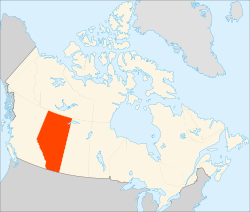 Alberta |
British Columbia |
 Manitoba |
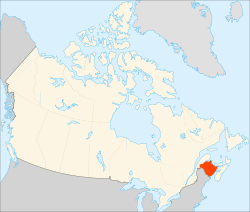 New Brunswick |
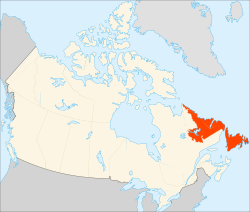 Newfoundland and Labrador |
 Nova Scotia |
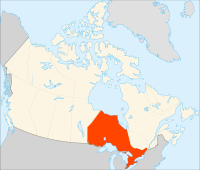 Ontario |
Prince Edward Island |
 Quebec |
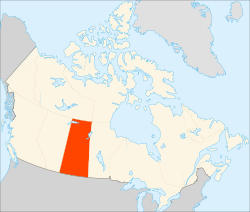 Saskatchewan |
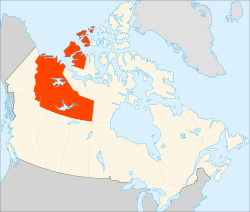 Northwest Territories |
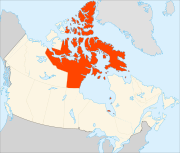 Nunavut |
Yukon |
France |
|
See also
- Canadian Register of Historic PlacesCanadian Register of Historic PlacesThe Canadian Register of Historic Places is an online, searchable database that includes listings of historic places important to communities, cities, provinces, territories, and the nation...
- National symbols of CanadaNational symbols of CanadaNational symbols of Canada are the symbols that are used in Canada and abroad to represent the country and its people. Prominently, the use of the maple leaf as a Canadian symbol dates back to the early 18th century, and is depicted on its current and previous flags, the penny, and on the coat of...
- Royal monuments in CanadaRoyal monuments in CanadaIn Canada, a number of monuments have been erected to honour royal individuals, whether a member of the past French Royal Family, British Royal Family, or present Canadian Royal Family, thus reflecting the country's status as a constitutional monarchy under the Canadian Crown.-Alberta:-British...
- Seven Wonders of CanadaSeven Wonders of CanadaThe Seven Wonders of Canada was a 2007 competition sponsored by CBC Television's The National and CBC Radio One's Sounds Like Canada. They sought to determine Canada's "seven wonders" by receiving nominations from viewers, and then from on-line voting of the short list. After the vote, a panel of...
External links
- National Historic Sites of Canada - Parks Canada
- Historic places - Administered by Parks Canada

